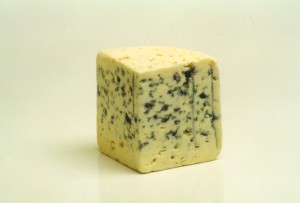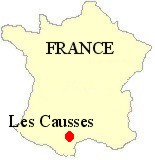
|
|
|||||
Long ago, tradition has it, a young shepherd stopped to rest at the mouth of a Cambalou cave in the Causses, south-west France. While his sheep foraged among the rocky debris for edible twigs and dried grass, he turned to his own daily ration, which consisted of curdled milk and a piece of black bread. Then, seeing his girlfriend pass by in the distance, he abandoned the little meal on a rock and raced after her. Several days later, the shepherd happened to re-visit the scene, where he found the food he had left still there. He sank his teeth into the now solidified milk and, to his great surprise, found it delicious. Taking a closer look, he also noticed that the cheese was spangled with small bluish spots. With this, a young love-smitten shepherd became the legendary inventor of a cheese that would travel the world over and honour the tables of kings and emperors. The makers of Roquefort in Les Causses, were first granted a monopoly on its production by a charter signed by Charles V1 in 1411. This Monopoly has been confirmed at frequent intervals ever since. The cheese is made from the unpasteurised milk of the Lacaune breed of sheep, and then matured in the Cambalou caves. The caves, which maintain a temperature of 6-8ºC, are ventilated with currents of air known as fleurines, providing ideal conditions for the development of the mould now known as Penicillium roquefortii. This mould, which once grew naturally, is now partly induced by being sprinkled in powdered form onto the curds as they are ladled into the moulds. These cheeses are then pierced with steel needles during the three-month ripening period. For the final part of this time the cheeses are closely wrapped in tin foil so that the finished product has virtually no rind. The green-blue veining should be evenly distributed throughout the cheese and the paste should be creamy white and rather buttery. The Roquefort we sell at the Teddington Cheeses is made in a farm-house and is one of the last to be made by hand (only two remain which stay loyal to the original hand-made methods). It is called Roquefort le Troupeau. Each cheese is approximately 20cm in diameter, 10cm high, weighs 2.5kg and has a fat content of 45%. The majority of Roquefort cheeses produced today are made in large creameries and, unfortunately, many of the exported Roqueforts tend to be over salted to improve their keeping qualities. Roquefort is excellent as a table cheese. It is also ideal for sauces, salads and salad dressings. Its full distinctive flavour has made it popular in the kitchen. Roquefort can be enjoyed with sweet dessert wines and Port. Click here or press your 'Back' button to return |
|
|||||
| All articles © www.teddingtoncheese.co.uk | ||||||
